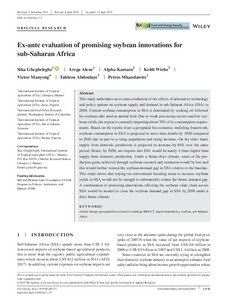| dc.contributor.author | Gbegbelegbe, S. |
| dc.contributor.author | Alene, A. |
| dc.contributor.author | Kamara, A. |
| dc.contributor.author | Wiebe, K. |
| dc.contributor.author | Manyong, Victor M. |
| dc.contributor.author | Abdoulaye, T. |
| dc.contributor.author | Mkandawire, P. |
| dc.date.accessioned | 2019-12-04T11:33:55Z |
| dc.date.available | 2019-12-04T11:33:55Z |
| dc.date.issued | 2019-05-16 |
| dc.identifier.citation | Gbegbelegbe, S., Alene, A., Kamara, A., Wiebe, K., Manyong, V., Abdoulaye, T. & Mkandawire, P. (2019). Ex‐ante evaluation of promising soybean innovations for sub‐Saharan Africa. Food and Energy Security, 1-16. |
| dc.identifier.issn | 2048-3694 |
| dc.identifier.uri | https://hdl.handle.net/20.500.12478/5846 |
| dc.description | Open Access Journal |
| dc.description.abstract | This study undertakes an ex‐ante evaluation of the effects of alternative technology and policy options on soybean supply and demand in sub‐Saharan Africa (SSA) to 2050. Current soybean consumption in SSA is dominated by cooking oil followed by soybean cake used as animal feed. Due to weak processing sectors and low soybean yields, the region is currently importing about 70% of its consumption requirements. Based on the results from a geospatial bio‐economic modeling framework, soybean consumption in SSA is projected to more than double by 2050 compared to 2010 due in part to a rising population and rising incomes. On the other hand, supply from domestic production is projected to increase by 80% over the same period. Hence, by 2050, net imports into SSA would be nearly 4 times higher than supply from domestic production. Under a future drier climate, some of the production gains achieved through soybean research and extension would be lost and this would further worsen the soybean demand gap in SSA relative to the baseline. This study shows that relying on conventional breeding alone to increase soybean yields in SSA would not be enough to substantially reduce the future demand gap. A combination of promising innovations affecting the soybean value chain across SSA would be needed to close the soybean demand gap in SSA by 2050 under a drier future climate. |
| dc.description.sponsorship | Bill & Melinda Gates Foundation |
| dc.format.extent | 1-16 |
| dc.language.iso | en |
| dc.rights | CC-BY-4.0 |
| dc.subject | Climate Change |
| dc.subject | Soybeans |
| dc.subject | Production |
| dc.subject | Africa South Of Sahara |
| dc.title | Ex‐ante evaluation of promising soybean innovations for sub‐Saharan Africa |
| dc.type | Journal Article |
| dc.description.version | Peer Review |
| cg.contributor.crp | Agriculture for Nutrition and Health |
| cg.contributor.crp | Maize |
| cg.contributor.crp | Policies, Institutions and Markets |
| cg.contributor.crp | Roots, Tubers and Bananas |
| cg.contributor.affiliation | International Institute of Tropical Agriculture |
| cg.contributor.affiliation | International Food Policy Research Institute |
| cg.coverage.region | Africa |
| cg.coverage.region | Central Africa |
| cg.coverage.region | East Africa |
| cg.coverage.region | Southern Africa |
| cg.coverage.region | West Africa |
| cg.coverage.country | Benin |
| cg.coverage.country | Burkina Faso |
| cg.coverage.country | Cameroon |
| cg.coverage.country | Ethiopia |
| cg.coverage.country | Malawi |
| cg.coverage.country | Nigeria |
| cg.coverage.country | Rwanda |
| cg.coverage.country | Tanzania |
| cg.coverage.country | Zambia |
| cg.coverage.country | Zimbabwe |
| cg.creator.identifier | Arega Alene: 0000-0002-2491-4603 |
| cg.creator.identifier | Alpha Kamara: 0000-0002-1844-2574 |
| cg.creator.identifier | Victor Manyong: 0000-0003-2477-7132 |
| cg.creator.identifier | Tahirou Abdoulaye: 0000-0002-8072-1363 |
| cg.researchtheme | PLANT PRODUCTION & HEALTH |
| cg.researchtheme | SOCIAL SCIENCE & AGRICUSINESS |
| cg.isijournal | ISI Journal |
| cg.authorship.types | CGIAR multi-centre |
| cg.iitasubject | Agribusiness |
| cg.iitasubject | Grain Legumes |
| cg.iitasubject | Impact Assessment |
| cg.iitasubject | Plant Health |
| cg.iitasubject | Plant Production |
| cg.iitasubject | Soybean |
| cg.journal | Food and Energy Security |
| cg.howpublished | Formally Published |
| cg.accessibilitystatus | Open Access |
| local.dspaceid | 105483 |
| cg.targetaudience | Scientists |
| cg.identifier.doi | https://dx.doi.org/10.1002/fes3.172 |

